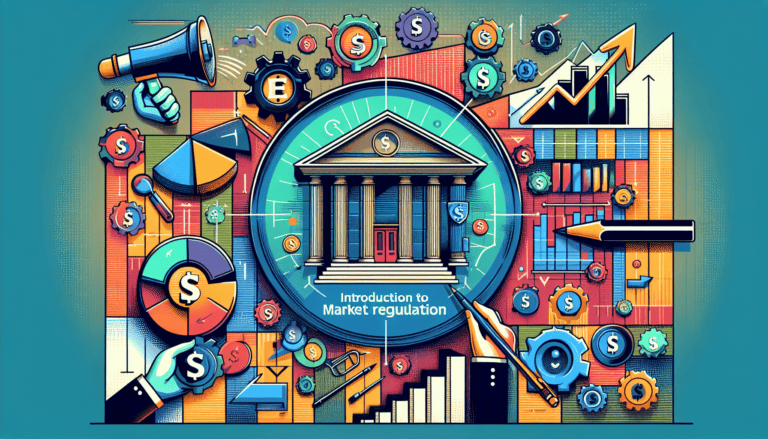Exploring Market Cycles and Economic Indicators

Introduction to Financial Markets
The financial markets are a complex system where securities are bought, sold, and traded. They play a pivotal role in the global economy, influencing everything from economic growth to individual wealth. For those new to the investment world, understanding the fundamental concepts, such as economic indicators and market cycles, is essential.
Economic Indicators Defined
Economic indicators are statistical data points that analysts and economists use to gauge the current state of the economy and predict future performance. These indicators can be classified into different types, such as leading, lagging, and coincident indicators. Leading indicators provide insight into future economic trends and can include metrics like stock market performance, building permits, average weekly hours worked in manufacturing, and consumer sentiment. They are predictive in nature and are used to anticipate changes before the economy as a whole changes (Investopedia).
Importance of Market Cycles
Market cycles represent the natural ebb and flow of economic growth and contraction within financial markets. These cycles are composed of four distinct phases: expansion, peak, contraction, and trough. Understanding these phases is crucial for investors as they indicate the overall health of the economy and can influence investment decisions. Economic indicators are instrumental in identifying where the market currently stands within these cycles and what might be expected in the near future, thereby aiding investors in making better-informed decisions about when to purchase or sell assets (Investopedia).
New investors should familiarize themselves with these concepts to navigate the markets effectively. Further reading on topics like market efficiency theory, understanding market sentiment, and introduction to portfolio management can provide additional foundational knowledge. Additionally, understanding the history of financial markets and the function and role of financial markets can offer a broader perspective on current market dynamics.
Unpacking Economic Indicators
Economic indicators are vital tools that investors and analysts use to interpret the health of the economy and predict future market activities. These indicators fall into different categories, each serving a unique purpose in the realm of financial analysis.
Leading Indicators Explained
Leading indicators are forward-looking signals that provide early warnings about the direction the economy is headed. They are crucial for investors who are trying to anticipate changes in market cycles and economic conditions. Examples of leading indicators include stock market returns, building permits, and indices of consumer expectations. These indicators can provide insights into future economic performance and are often used to predict upturns or downturns in economic activity.
According to Investopedia, leading indicators are particularly useful because they help investors and economists set expectations for the future. For instance, an increase in building permits suggests a future uptick in construction activity, which could lead to more jobs and, by extension, economic growth.
| Leading Indicator | Description |
|---|---|
| Stock Market Returns | Reflects investor confidence and capital market conditions |
| Building Permits | Indicates future construction activity and investment |
| Consumer Expectations | Measures the economic outlook of households |
Lagging Indicators Identified
Lagging indicators, on the other hand, offer confirmation of patterns and trends already in play within the economy. They are most useful for confirming what leading indicators predict. Examples include the unemployment rate and inflation rate, which solidify the trends indicated by leading indicators. Lagging indicators are valuable for their ability to provide evidence that an economic shift detected by leading indicators has actually occurred.
As detailed by Investopedia, these indicators can confirm long-term trends and are particularly helpful for reinforcing investment decisions or policy changes. They are less useful for prediction since they reflect past conditions.
| Lagging Indicator | Description |
|---|---|
| Unemployment Rate | Shows the percentage of the labor force that is jobless |
| Inflation Rate | Measures the rate at which the general level of prices for goods and services is rising |
The Role of GDP and CPI
The Gross Domestic Product (GDP) and the Consumer Price Index (CPI) are two pivotal economic indicators that play a significant role in assessing the health of an economy. GDP represents the total market value of all goods and services produced over a specific time period and is a primary measure of economic growth. The CPI, meanwhile, gauges the average change over time in the prices paid by consumers for a basket of goods and services, making it a key indicator of inflation.
Both GDP and CPI are crucial for understanding market cycles and economic indicators, as they provide insights into the overall well-being of the economy. For example, strong GDP growth coupled with stable CPI readings might indicate a healthy, growing economy, which could in turn influence investment strategies and market outlooks.
Investors and economic analysts can utilize these indicators to determine the current phase of the market cycle, potentially guiding investment decisions and providing a clearer understanding of the economic landscape. By monitoring changes in GDP and CPI, investors can gain a sense of the economy’s momentum and the possible impact on financial markets and the economy.
Understanding these economic indicators is crucial for beginner investors who are navigating the financial markets. By staying informed about the roles of leading and lagging indicators, as well as the implications of GDP and CPI, investors can develop a more nuanced approach to portfolio management and investment strategy.
Understanding Market Cycles
Grasping the intricacies of market cycles is vital for beginner investors who are learning to navigate the ebb and flow of the financial markets. These cycles, which consist of alternating periods of economic growth and contraction, not only affect individual investments but also the economy as a whole.
The Four Phases
Market cycles are typically broken down into four distinct phases: expansion, peak, contraction, and trough. Each phase represents a different stage of economic growth or decline and has unique characteristics that can influence investment decisions:
- Expansion: This phase is marked by increasing economic activity, rising consumer confidence, and generally bullish stock market conditions.
- Peak: At this point, the economy is running at full steam, but growth rates begin to plateau, signaling a potential turning point.
- Contraction: Economic activity starts to decrease, often leading to falling stock prices and increased investor caution.
- Trough: The economy hits its lowest point, but it’s also the stage where conditions may begin to improve, setting the stage for the next expansion.
These phases can last for varying lengths of time and are often identified by looking at economic indicators such as GDP growth and consumer spending (Investopedia).
Duration and Impact
The duration of each market cycle phase can greatly impact investment strategies. For instance, a prolonged expansion phase might offer sustained opportunities for growth investments, while a contraction phase may require a defensive approach. The duration of these phases is not fixed and can be influenced by a myriad of factors, both economic and geopolitical.
| Phase | Typical Duration | Impact |
|---|---|---|
| Expansion | Several years | Bullish stock market |
| Peak | Variable | Transition point |
| Contraction | Several months to years | Bearish stock market |
| Trough | Variable | Potential for recovery |
Understanding the duration and impact of each phase can help investors to adjust their investment strategies for optimal performance.
External Factors
A number of external factors can influence market cycles, including but not limited to:
- Monetary Policy: Decisions by central banks regarding interest rates can either stimulate or cool down the economy.
- Political Events: Elections, regulatory changes, and international relations can create uncertainty or confidence in the markets.
- Technological Advancements: Innovation can lead to new industries and growth opportunities, affecting market dynamics (Investopedia).
- Globalization: The interconnectedness of global economies can mean that events in one part of the world affect others (the impact of globalization on financial markets).
By acknowledging these factors and their potential influence on market cycles, investors can gain a more nuanced understanding of the forces at play in the financial markets and the economy. This knowledge is crucial for crafting investment strategies that are resilient to economic changes.
Indicators and Investment Decisions
In the realm of finance, economic indicators are crucial tools that help investors understand the current state of the economy and anticipate future trends. These indicators can significantly influence investment decisions by shedding light on the health and direction of financial markets.
Analyzing Stock Performance
Stock performance is typically seen as a leading economic indicator as it reflects investor expectations about future economic conditions. When stocks perform well, it’s often interpreted as a sign of economic strength and investor confidence, while a downturn may signal economic trouble ahead.
For beginner investors, analyzing stock performance requires not only looking at current prices but also studying historical trends and market volatility. One way to get started is by familiarizing oneself with market indices, which provide a snapshot of the overall market performance.
Consumer Confidence and Spending
Consumer confidence is a measure of how optimistic consumers are about the state of the economy and their own financial situation. It directly impacts how much consumers are willing to spend. High consumer confidence typically leads to increased spending, which can boost economic growth.
Conversely, when consumer confidence is low, spending tends to decrease, which can slow down the economy. Tracking consumer confidence can give investors insight into future spending patterns and help them predict which sectors might see growth.
| Consumer Confidence Level | Spending Behavior |
|---|---|
| High | Increased spending on goods and services |
| Moderate | Cautious spending, preference for essentials |
| Low | Reduced spending, potential savings increase |
Interest Rates and Inflation
Interest rates and inflation are closely intertwined and are key economic indicators that can influence investment decisions. Central banks, such as the Federal Reserve, adjust interest rates to control inflation and stabilize the economy. Lower interest rates can encourage borrowing and investing, leading to economic expansion. Higher interest rates, on the other hand, can help cool down an overheating economy and curb inflation.
Inflation erodes purchasing power and can affect consumer spending habits. Investors need to watch for changes in interest rates and inflation to protect their investment returns from being diminished by rising costs.
| Interest Rate Change | Expected Market Reaction |
|---|---|
| Decrease | Potential increase in stock investments |
| Increase | Possible shift towards fixed-income assets |
Investors can utilize these indicators to make informed decisions, whether they’re considering portfolio management or looking to adjust their investment strategies based on market cycles. By keeping an eye on these economic signals, one can better navigate the complexities of the financial markets and enhance their investment approach.
Navigating Market Cycles
Navigating market cycles is a critical skill for beginner investors who are looking to understand the ebb and flow of financial markets. Recognizing the different stages of market cycles and understanding how to adjust investment strategies accordingly can lead to more informed decisions and potential investment success.
Recognizing Accumulation and Markup
The accumulation phase is the initial stage of a market cycle, where savvy investors, often referred to as “smart money,” begin to purchase stocks at lower prices. This period is typically marked by low trading volume and minimal public interest Investopedia. Detecting the signs of accumulation can be challenging, as it may require analysis beyond surface-level price movements, including a deep dive into understanding market liquidity and market efficiency theory.
Following accumulation, the markup stage occurs when stock prices start to rise sharply, accompanied by increased trading volumes. During this time, the general public begins to take notice, and market optimism grows. Recognizing the markup phase is crucial as it presents an opportunity for investors to capitalize on the upward trend.
| Market Cycle Stage | Characteristics | Investor Action |
|---|---|---|
| Accumulation | Low prices, low volume, smart money buying | Monitor for buying opportunities |
| Markup | Rising prices, high volume, public interest | Consider joining the uptrend |
Identifying Distribution and Markdown
Conversely, the distribution stage signifies a turning point where stock prices begin to wane, and trading volumes decline. In this phase, experienced investors may start to sell off their holdings, securing profits from the previous growth stages. This stage often brings increased market caution and uncertainty, and it can serve as a signal for investors to consider safeguarding their portfolios Investopedia.
The markdown phase is marked by a significant decline in stock prices and low trading volumes. Panic selling and market pessimism are common during this period. However, it is also the stage where smart money investors may start to accumulate stocks again, preparing for the next cycle. Understanding these patterns can aid investors in recognizing potential exit points and opportunities to buy at depressed prices.
| Market Cycle Stage | Characteristics | Investor Action |
|---|---|---|
| Distribution | Decreasing prices, declining volume, smart money selling | Be cautious, consider taking profits |
| Markdown | Sharp price decline, low volume, panic selling | Look for accumulation signs |
Adjusting Investment Strategies
Understanding market cycles and economic indicators is essential for investors to make strategic decisions regarding asset allocation, risk management, and investment timing. Recognizing the market’s current stage enables investors to tailor their strategies to either maximize returns or mitigate risks Investopedia.
Investors may need to adjust their strategies by diversifying their portfolio, reassessing their risk tolerance, or considering alternative investment options like public and private markets. It’s also prudent to stay informed about financial markets and the economy and to keep an eye on the role of central banks in financial markets.
Staying updated with educational resources such as an introduction to portfolio management and primary vs. secondary markets can further enhance an investor’s ability to navigate through various market cycles effectively. By applying this knowledge, investors can develop a more resilient and flexible approach to their investment journey.
Risks and Considerations
Investing in financial markets involves a range of risks and considerations. A comprehensive understanding of market cycles and economic indicators is crucial for beginner investors looking to navigate the complexities of the investment world.
Sensitivity to Economic Changes
Economic indicators play a pivotal role in financial markets as they reflect the health and direction of the economy. Investors must be aware of how sensitive certain investments can be to economic changes. For instance, stocks may react swiftly to shifts in economic data such as employment rates or consumer spending.
Being attuned to economic indicators can provide valuable insights into potential market movements. For example, a rise in the consumer price index (CPI) may signal increasing inflation, which could lead to higher interest rates and affect the performance of various asset classes. Investors can access comprehensive information on these indicators through reliable sources like Investopedia.
Long-Term Perspective on Investments
When considering market cycles, it’s essential for investors to adopt a long-term perspective. Market cycles, consisting of the phases of accumulation, markup, distribution, and markdown, can span several years. During these cycles, short-term market fluctuations can be misleading and may prompt ill-timed investment decisions.
A long-term approach allows investors to ride out the volatility associated with different market phases. By focusing on the fundamentals of investment, such as asset allocation and diversification, investors can better weather the inevitable ups and downs that come with market cycles.
Monitoring Economic and Political Events
Market cycles and economic indicators are also influenced by external factors, such as monetary policy decisions by central banks, political events, and technological advancements. These factors can create fluctuations in the stock market and overall economic activity, impacting investor sentiment and confidence.
For instance, changes in interest rates set by central banks can greatly influence market liquidity and the attractiveness of different asset classes. Political stability or instability can also sway market sentiment, leading to either confidence or caution among investors.
It is crucial for investors to stay informed about these external factors and understand their potential impact on financial markets. Regular monitoring of economic and political events, as well as advancements in technology, can help investors anticipate market trends and adjust their strategies accordingly.
Investors who seek to deepen their understanding of these dynamics can explore topics like the impact of globalization on financial markets or the role of central banks in financial markets.
By being mindful of these risks and considerations, and staying informed through continuous education and vigilance, beginner investors can navigate the world of financial markets with greater confidence and strategic acumen.





